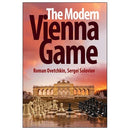Description
The Modern Vienna Game
by Roman Ovetchkin and Sergei Soloviov
Paperback (softcover), 428 pages
The Vienna set-up aims for very aggressive play, which often includes sacrifices, but White prefers to be on the safe side, without burning all the bridges and to try to justify his actions from the point of view of positional play as well. This is how this usually happens. At first, he deploys his minor pieces to active positions, then he advances the thematic move f4, castles (usually on the kingside) and begins an attack only after all this.
It may seem strange, but despite the fact that the move 2.Nc3 has been played for more than a hundred years, there has not been defined a clear-cut scheme for meeting this set-up. We had to make decisions how to play with White practically from the first several moves. Should he thrust immediately f4, or begin at first with d3? Should he advance his pawn to f5, or prefer a quick piece development? For example, after 2...Nf6 3.Bc4 Bc5, should White play at first d3, fortifying his e4-pawn? We have come to the conclusion that the move 4.f4!? is more precise. Still, after 4.f4 d6, there arises another question – 5.Nf3, or 5.d3? It often happens that there arise the same positions after these moves, but still, we had to analyse after which move White maintains a more convincing advantage if Black replies with the principled move 5...Ng4...
We should emphasize as a very positive moment that by choosing the Vienna Game, White follows his own line of playing. This does not happen after the move 2.Nf3 when Black can choose then between the numerous variations of the Ruy Lopez (or the rather solid Steinitz Defence Deferred, or the super-solid Berlin Wall, or the sharp Marshall Attack). In addition, Black can go for the seemingly peaceful Petroff Defence.
Download the contents page of this book here.
Chess Stars
Payment & Security
Your payment information is processed securely. We do not store credit card details nor have access to your credit card information.


